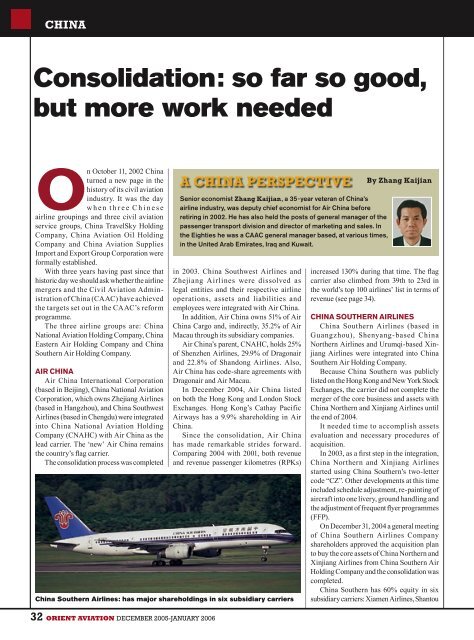You also want an ePaper? Increase the reach of your titles
YUMPU automatically turns print PDFs into web optimized ePapers that Google loves.
CHINA<br />
Consolidation: so far so good,<br />
but more work needed<br />
On October 11, 2002 China<br />
turned a new page in the<br />
history of its civil aviation<br />
industry. It was the day<br />
w h e n t h r e e C h i n e s e<br />
airline groupings and three civil aviation<br />
service groups, China TravelSky Holding<br />
Company, China <strong>Aviation</strong> Oil Holding<br />
Company and China <strong>Aviation</strong> Supplies<br />
Import and Export Group Corporation were<br />
formally established.<br />
With three years having past since that<br />
historic day we should ask whether the airline<br />
mergers and the Civil <strong>Aviation</strong> Administration<br />
of China (CAAC) have achieved<br />
the targets set out in the CAAC’s reform<br />
programme.<br />
The three airline groups are: China<br />
National <strong>Aviation</strong> Holding Company, China<br />
Eastern Air Holding Company and China<br />
Southern Air Holding Company.<br />
AIR CHINA<br />
Air China International Corporation<br />
(based in Beijing), China National <strong>Aviation</strong><br />
Corporation, which owns Zhejiang Airlines<br />
(based in Hangzhou), and China Southwest<br />
Airlines (based in Chengdu) were integrated<br />
into China National <strong>Aviation</strong> Holding<br />
Company (CNAHC) with Air China as the<br />
lead carrier. The ‘new’ Air China remains<br />
the country’s flag carrier.<br />
The consolidation process was completed<br />
A CHINA PERSPECTIVE<br />
Senior economist Zhang Kaijian, a 35-year veteran of China’s<br />
airline industry, was deputy chief economist for Air China before<br />
retiring in 2002. He has also held the posts of general manager of the<br />
passenger transport division and director of marketing and sales. In<br />
the Eighties he was a CAAC general manager based, at various times,<br />
in the United Arab Emirates, Iraq and Kuwait.<br />
China Southern Airlines: has major shareholdings in six subsidiary carriers<br />
32 ORIENT AVIATION DECEMBER 2005-JANUARY 2006<br />
in 2003. China Southwest Airlines and<br />
Zhejiang Airlines were dissolved as<br />
legal entities and their respective airline<br />
operations, assets and liabilities and<br />
employees were integrated with Air China.<br />
In addition, Air China owns 51% of Air<br />
China Cargo and, indirectly, 35.2% of Air<br />
Macau through its subsidiary companies.<br />
Air China’s parent, CNAHC, holds 25%<br />
of Shenzhen Airlines, 29.9% of Dragonair<br />
and 22.8% of Shandong Airlines. Also,<br />
Air China has code-share agreements with<br />
Dragonair and Air Macau.<br />
In December 2004, Air China listed<br />
on both the Hong Kong and London Stock<br />
Exchanges. Hong Kong’s Cathay Pacific<br />
Airways has a 9.9% shareholding in Air<br />
China.<br />
Since the consolidation, Air China<br />
has made remarkable strides forward.<br />
Comparing 2004 with 2001, both revenue<br />
and revenue passenger kilometres (RPKs)<br />
By Zhang Kaijian<br />
increased 130% during that time. The flag<br />
carrier also climbed from 39th to 23rd in<br />
the world’s top 100 airlines’ list in terms of<br />
revenue (see page 34).<br />
CHINA SOUTHERN AIRLINES<br />
China Southern Airlines (based in<br />
Guangzhou), Shenyang-based China<br />
Northern Airlines and Urumqi-based Xinjiang<br />
Airlines were integrated into China<br />
Southern Air Holding Company.<br />
Because China Southern was publicly<br />
listed on the Hong Kong and New York Stock<br />
Exchanges, the carrier did not complete the<br />
merger of the core business and assets with<br />
China Northern and Xinjiang Airlines until<br />
the end of 2004.<br />
It needed time to accomplish assets<br />
evaluation and necessary procedures of<br />
acquisition.<br />
In 2003, as a first step in the integration,<br />
China Northern and Xinjiang Airlines<br />
started using China Southern’s two-letter<br />
code “CZ”. Other developments at this time<br />
included schedule adjustment, re-painting of<br />
aircraft into one livery, ground handling and<br />
the adjustment of frequent flyer programmes<br />
(FFP).<br />
On December 31, 2004 a general meeting<br />
of China Southern Airlines Company<br />
shareholders approved the acquisition plan<br />
to buy the core assets of China Northern and<br />
Xinjiang Airlines from China Southern Air<br />
Holding Company and the consolidation was<br />
completed.<br />
China Southern has 60% equity in six<br />
subsidiary carriers: Xiamen Airlines, Shantou








![OAMag-V7N4-Cover [Converted] - Orient Aviation](https://img.yumpu.com/48598575/1/190x255/oamag-v7n4-cover-converted-orient-aviation.jpg?quality=85)








